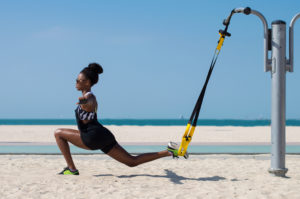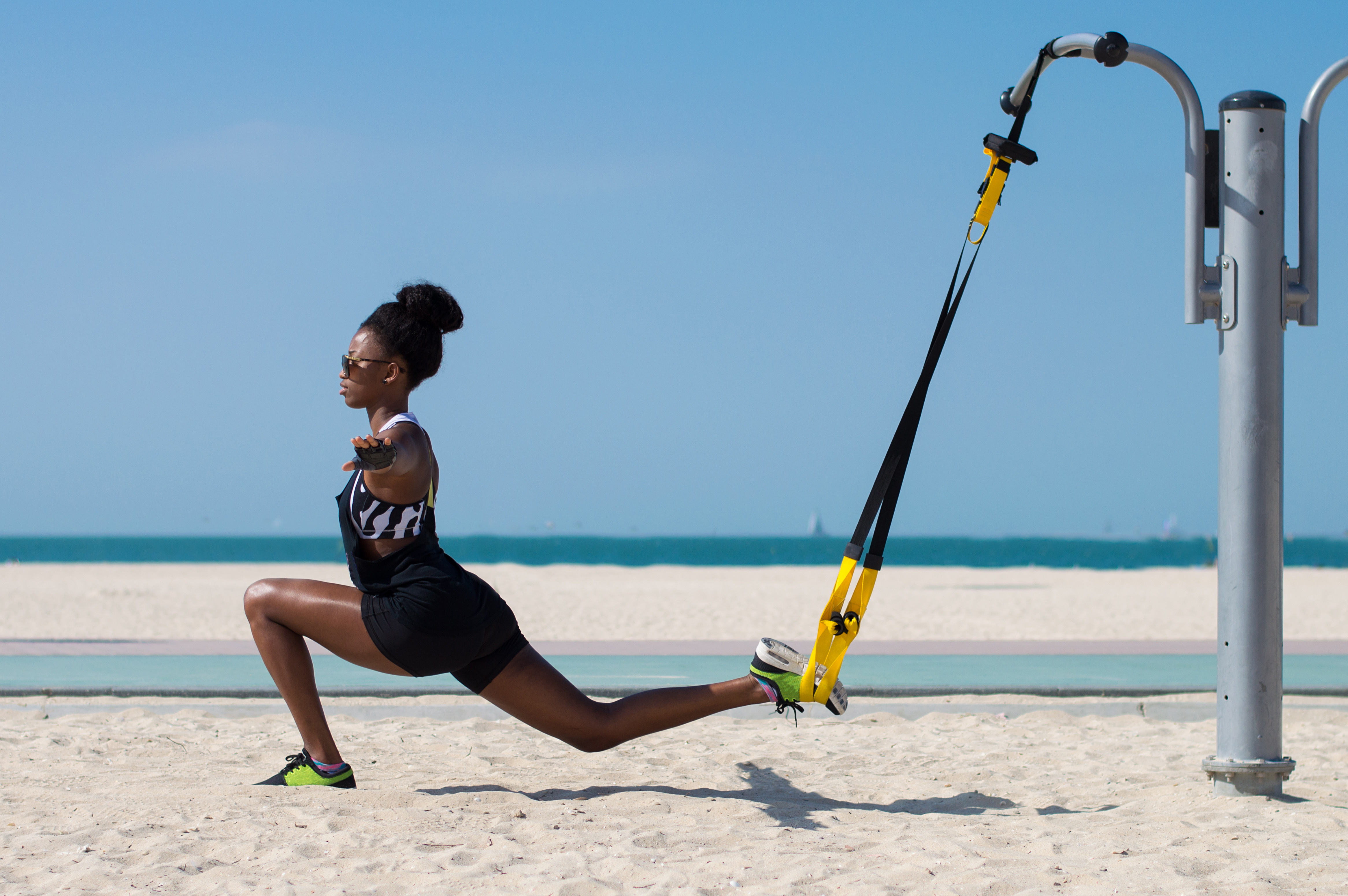
Suspension training is a training method that uses gravity suspension and an individual’s own body weight to build strength and improve balance. This mode of training was popularized by the Navy SEALs and has become well-known in the fitness community as a way to get a dynamic and challenging workout without using weights. The system consists of straps or slings that are securely attached to metal bars or another strong support. You can put your feet or hands in the attached stirrups and dangle in the air. From this position, you can do a variety of exercises that work every muscle in your body.
For those who aren’t comfortable with the idea of hanging from a bar, there is a tamer approach. You can grab on to the straps attached bar and angle your body back as you hold the straps. This can serve as a starting point for doing a variety of exercises. This approach, where your feet are firmly on the floor, is more popular with beginners for obvious reasons. By switching the angle of your body when you lead back, you can place more or less emphasis on certain muscle groups. You can also adjust the height of the handles, hand position, and the height of your feet to change how a muscle is targeted and the intensity.
The Benefits of Suspension Training
One of the biggest advantages of suspension training is the ability to work your body in multiple planes of motion. The problem with some strength-training exercises that use dumbbells and barbells is you’re working in only one or two planes. Plus, suspension training is strongly suited to working the core muscles. That’s important for reducing the risk of injury. Suspension training also offers incredible diversity. You can do hundreds of different exercises using suspension equipment, many of which target the core muscles along with muscles in the upper and lower body.
Research shows suspension training is highly effective at targeting muscles in the core, including the abdominal muscles. This includes the transversus abdominis, a deep abdominal muscle that is difficult to activate with conventional strength training exercises. The transverse abdominis helps support the lower back and pulls in the abdominal region like a girdle. Suspension movements also effectively target the muscles that support the spine. Therefore, research suggests this form of training may be beneficial for adults with lower back pain. Studies also show even older adults can safely use the straps or slings to perform a variety of exercises that improve strength and balance.
Another advantage of suspension training is it builds functional strength. Functional exercises are those that emulate the movements we do in daily life, like picking up heavy objects, stretching overhead to pick up an item off a shelf, or carrying an object down a flight of stairs. Functional training reinforces movement patterns that help us stay strong in a functional way. It’s not just for building big biceps or six-pack abs, it’s about being functionally fit.
Suspension systems are also portable. The straps are so light you can easily carry them with you when you travel. All you need is a sturdy object to attach them to. You can take it you the park, beach and even workout it your hotel room.
Are There Disadvantages of Suspension Training?
One concern about suspension training is the potential risk of injury for those who are new to this type of training. Obviously, the risk of injuring yourself is higher if you dangle your feet from a strap as opposed to grabbing the straps with your arms leaning your body back and working with the system with your feet planted on the ground. But, training on a suspension system takes a certain amount of stability and core strength. One concern is that less fit people who lack core strength could injure themselves with such core-intensive workouts. One way to lower the risk is to develop a baseline level of core strength before attempting suspension training.
How to Anchor the Straps
Suspension training systems consist of long straps with a handle at one end. The other end is attached to a sturdy object. People use a variety of objects to attach the straps to. For example, you can adapt a door frame or hook one to a pull-up bar. You can purchase single or dual mount systems. Single mounts have both straps attached to a single point while dual mounts have straps that anchor independently of each other. With dual mount system, you can adjust the width between the straps. People often prefer the more natural movements that the dual mount systems allow. That’s something to think about before purchasing a system.
What Exercises Can You Do with a Suspension Trainer?
When you use a suspension training system, you can suspend a body part above the ground to do exercises or you can angle your body away from the straps to add natural resistance. The types of exercises you can do with this system are almost endless.
For example, place your feet in the straps when you do push-ups. This will make the exercise more challenging as your feet are in an unstable position. You can also switch the position by positioning your arms in the straps when you do a push-up. Since you’re in a less stable position, the stabilizing muscles in your core will have to work harder. One study found that the core muscles are activated more with push-ups performed on a suspension trainer than on flat ground. Reverse ab curls and pikes are other exercises that specifically target the abs that you can do on a suspension trainer.
Suspension trainers add a different dimension to lower body training as well. You can do variations on squats and lunges, including single-leg lunges, as well as glute and hamstring scorchers, like hip bridges. Your upper body won’t be left out either. With suspension training, you can variations on rows and presses as well as old favorites, like biceps curls and triceps extensions, all while using the straps.
Conclusion
Suspension training adds a new dimension to strength training. Because you’re doing exercises partially suspended or at an angle, it creates more instability and that helps strengthen your core muscles more than weight training on a stable surface. Plus, it adds a balance challenge. However, beginners should build up a baseline level of core strength and fitness first.
References:
Int J Exerc Sci. 2015; 8(3): 224-233.
Journal of Strength and Conditioning Research: November 2014 – Volume 28 – Issue 11 – p 3049-3055
